Written by Joel T. Lewis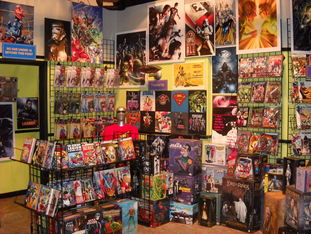 Recently I found myself overwhelmed and frustrated during a recent visit to my local comic shop. I had just heard the news about Carrie Fisher’s passing and was in an awful funk: drifting from section to section and while I brought home some pretty sweet Issues of West Coast Avengers it made me sad to think that that trip wasn't as fun as it normally is. So I decided to write out some of the things I’ve learned from my comic book collecting experiences that help me make the most out of a trip to the comic book shop, to remind me how magical it is to shop for these incredible books and to help out anyone else who might be feeling a touch overwhelmed about starting their own collection as well. Your First Trip When going to a comic shop for the first time it's important to remember that the name of the game is fun. Comic books are meant to be fun: the colorful heroes, the wacky villains, and action-packed issues are for everyone so don't feel out of your element in a comic shop. Before you visit a comic shop check their website to make sure there are no events going on when you're planning on visiting. Lots of comic shops host trading card tournaments, auctions, and other events that are really cool, but might interfere with your trip. You don't want to squeeze around tables and chairs to get to the comics and you'll save yourself some funny looks from those attending the event. A note about comic shop owners: in my experience the owners, or employees of comic shops can vary from super polite and helpful to stoic and stand-offish. Despite their attitude, owners are more often than not huge comic book fans and it never hurts to ask for a recommendation. Usually it's helpful to have a hero or specific interest in mind when asking for a recommendation Example: I'd like something with a female main character set in space or I'd like something quirky but not necessarily about a superhero. In the event that the owner of your local shop is rude to you don’t be discouraged from collecting comics, we’re not all jerks! Do not allow yourself to be treated rudely, you can always find another shop to call home. When a shop-owner is nowhere in sight, or if you’re too shy to ask (which is perfectly fine) I've found that going with a friend who has their own comic collection is very helpful especially on your first trip to a comic shop. They'll usually know the lay of the land and will be able to steer you towards the unique stuff. Plus, they will be thrilled to introduce you to their world and will leap at the chance to visit a shop themselves. While I will try to cover as much as I can to help with your comic shop experience in this article, there really is no substitute for a fellow nerd buzzing with excitement to show you around. 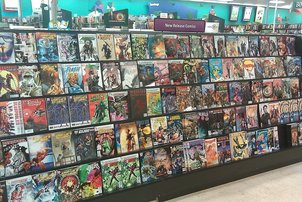 When starting your comic collection, I've found that your greatest ally is the dollar comic section. Typically, these sections are full of issues that don't have bags or boards, are haphazardly organized, and are the best place to discover new heroes. You get to feel the ink on your fingers as you search through the boxes, you get that great smell that only loose comics have, and you can pick up a bunch of different titles without breaking the bank. These bargain bins are a great way to try on a hero or two for size before committing to hunting down every issue. Also the beauty of the dollar comic is that it's meant to be read. You don't have to worry about the quality of the issue or its value. So you can pick it up and thumb through it again and again without worrying about ruining it. It is important to know that in this section it is rare to find a first issue or a complete run and when you’re starting out and that’s okay. I know the frustration of finding issues 2, 3, 7, and 8 with none of the fillers in sight, but that’s the beauty of comics, you can read around the gaps and then you have something to hunt for the next time. This is also a great section for judging a book by its cover. Though I wholeheartedly believe that a comic book cover lets you know whether or not you will enjoy the story inside, this is not always the case (see my article on Image Comics’ Trencher). The dollar section protects you from investing in a title whose cover promised one thing and whose contents delivered another. Another ally to the new comic book collector is the Trade Paperback (TPB or trades) section. These are bound editions of comics that collect a number of issues in one volume. These will save you some money and the strife of tracking down obscure issues in a series. They also serve as great starter sets for new collectors. Some of my favorite trades are the Marvel Essential Series volumes. They're a great set of books that collect the first appearance of Marvel superheroes and allow you to follow that character’s story from the very beginning. The Essential series is great for filling in the holes in your collection but the only drawback is that the issues are in black and white. Most trades nowadays are full color and collect 5-10 issues at a time. They're great for saving space on your shelves, easy to keep in good condition, and don't break the bank. Now most comic collectors have strategies and resources that they go to when planning a trip to the comic shop and I just wanted to share a few of my own that have helped me make the most of my trips. Make a List Usually comic book shops organize themselves by publisher (Marvel, DC, Image, Vertigo etc) and then alphabetically under those headings. So I've found it's helpful to keep a list of the issues I have and the issues I want in an excel or google sheets spreadsheet. This format allows me to get everything alphabetized quickly and prevents me from buying duplicate issues. Also having a google sheet accessible from my phone allows me to edit it as I shop. When making a list of issues I want to pick up there are a few strategies I employ. When searching for issues I'm missing from a certain run I like to search for them on mycomicshop.com, in addition to being a huge comic book vendor themselves they have an intuitive website that allows you to see pictures of every issue’s cover art and they give you a ballpark price so you can plan your budget. Also their archive even has pictures of the issues they don't have available so you know what issue number and cover to look for. Something else that I thought was really cool about their website is that they list all the variant covers in a series too which has helped me pick up some pretty sweet issues. 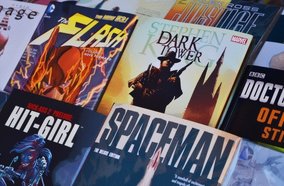 When I'm not filling in gaps in a series, I'm usually looking for appearances of a specific hero (usually Moon Knight) in different comics. One of the most valuable resources I've found for tracking down these issues is comicvine.gamespot.com. This site hosts a pretty exhaustive catalog of comic book characters and their appearances in different issues. While the website has its quirks the research they've compiled is impressive. A word of warning though: when they list all appearances of a character they mean all of them, even translations into French and Spanish. Be sure to double check that the issues you write down are in the language you read and will be available in your country. Also, I've found that sometimes when a character is listed as appearing in some of the bigger comic book events like Flashpoint or Civil War that appearance can be underwhelming. Unless your character is central to the plot of those stories an appearance can be as small as a silent cameo in a splash page (a panel taking up one or two whole pages) of a New York battle and that's it. This won't be a problem for the more well-known heroes but the more obscure ones get included but not showcased. Stick to Your List Comics can get expensive. Depending on the scarcity and condition of specific issues $8-10 a pop is not an uncommon price point for comics and believe me, that adds up fast. So it is important to budget for a specific set of issues and stick to it. Allow yourself about ten dollars of cushion to account for something cool you may not have researched but if you establish a budget beforehand sticking to it makes a big difference when you step up the register. Give Yourself Enough Time Comics contain entire worlds. It's easy to lose track of time between their pages so make sure you give yourself enough time to explore especially the first time. Depending on the size of your local shop I recommend giving yourself 1-2 hours so you don't feel rushed. I love comic books and everyone should feel welcome in a comic book shop. Hopefully this article will inspire some aspiring collectors to make a trek out to a shop and will help the veteran collectors out there make the most of their next hunt. Please feel free to comment and share your comic shop strategies below. I'd love to hear some new ones. Until next time, Geek On!
0 Comments
Written by Joel T. Lewis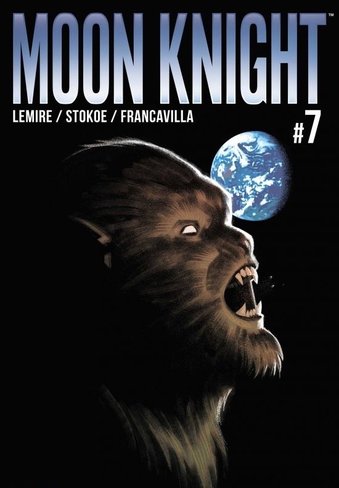 In this issue we get a more intimate look at the lunar dystopia of Captain Marc Spector brought to life in previous issues by artist James Stokoe. We catch up with Spector as he pilots his starship Moon Knight One against a legion of space werewolves who have taken over the earth and driven what remains of humanity to a lone outpost on the moon. This is humanity’s final stand. As Spector and the sinister General Lupinar trade passes above the surface of the moon, artist Stokoe throws silvery crescent moon fighters at the swarm of red predator ships that have come to end mankind. The panels are spectacular with the pale shimmering surface of the moon clashing against the black cloud of empty space while fighters dart and blaze deadly fire at each other. Then as Lupinar and Spector play out one final deadly game of chicken Marc struggles to focus as he slips into the reality of cab-driver Jake Lockley for a moment, then back to the moon, then back again. Stokoe’s visual style collides with Francesco Francavilla’s as Spector speeds toward Lupinar on the moon and Lockley’s cab smashes into an oncoming car on the mean streets of New York. The next page shows us Spector’s ejector seat cushioning his landing on the surface of the moon and Lockley thrown from the crumbling mess of his cab. This page is particularly striking because of the similar color pallet that bleeds through both artists’ panels. The orange and yellow of the two crashes smooth over what could’ve been a jarring transition between the neon streets of New York and the cold rocky surface of the moon. Spector emerges from the tangled wreck of Moon Knight 1 and calls to his co-pilot Frenchie. Hearing no response, Marc turns to survey the wreckage. Frenchie is dead for the second time this series (issue 4) but that is not the most unsettling thing we discover as we turn the page. Spector is still on the moon but this is not the moon or Captain Spector as drawn by James Stokoe. Instead of his wrecked Starfighter, Marc sees Jake Lockley’s cab smoking from the crash. As Marc discovers Frenchie’s fate Francavilla takes over for Stokoe, depicting both the cab from Lockley’s reality and Captain Spector, spacesuit and all. This transition indicates an important shift in the story. In my last recap I outlined the brilliance of using three artists (four if you include Greg Smallwood, and you should always include Greg Smallwood) to separate Moon Knight’s personas and their corresponding realities. By giving each identity a distinct visual style we are able to distinguish who’s doing what while also experiencing how jarring it must be for Moon Knight to constantly shift between these realities. Lockley’s cab and his artist’s (Francavilla) appearance on the moon shows how thin the divisions between Moon Knight’s identities have become. Events, characters, and the artists that draw them are bleeding into each other and the reader slowly starts to appreciates how damaged Moon Knight’s psyche really is. Luckily this particular madness abates after just one page and Lockley and his cab are back where they belong and are drawn by the correct artist. Shaken from the crash and his shifting identity Lockley shuffles towards the familiar neon lights of Gena’s Diner. Then we’re back on the moon with Spector as he watches the barrier protecting the moon base shatter. Spector rushes to attack the wolf responsible: General Lupinar. Stokoe’s panels leap off the page as they trade blows and beams of energy. Marc stands dumbfounded as he watches a horde of bloodthirsty space wolves pour into the last outpost of humanity. Numb with shock, Spector is defeated by Lupinar who bites his neck inviting him to turn and join the dominant species. We then shift back to Lockley who’s reeling from this latest switch. Shaking off his vision of the moon battle as a concussion-induced hallucination he finally makes it to the door of Gena’s diner. As the entry bell tinkles, Lockley senses that something’s gone horribly wrong, and he’s right. Gena’s is a blood bath and Jake has only enough time to call her name before sirens blare and a police officer with a bullhorn arrives. The cop calls him Marc Spector and informs him that he’s under arrest. Spector is spiraling out of control again but Lemire continues to deliver a spiral so unique and fresh that all I can do is enjoy the ride and patiently wait for the next installment. Until next time, Geek On! Written by Joel T. Lewis In issue 6 we catch up with Hollywood producer Steven Grant on the set of Marvel Studio’s newest film, “Moon Knight” and things are not running smoothly. Leading man Marc Spector storms off-set after a boom-mic operator ruins a take and an amateur director struggles to maintain control of his crew. Fed up with the day’s shooting, Grant and leading lady Marlene make their way home in an oddly familiar yellow cab. As they drive away Marlene encourages Grant to take over the film as director and reminds him of a fundraiser he's organized later that night at Mercy Hospital. The same Mercy Hospital where Marc Spector was a patient just a few issues ago. Grant and the cabbie lock eyes at the mention of the mental institution and suddenly Steven Grant melts away and Jake Lockley emerges into the techno-noir world brought to life by artist Francesco Francavilla. After discovering Crawley by the side of the road Lockley discovers that jumping off the pyramid as Spector in issue 5 didn’t end his madness. He’s still being manipulated by Khonshu and can’t distinguish between his personalities or their respective realities. Puzzled and frustrated by Crawley’s revelation Lockley opens the trunk of his cab to don the mantle of the Moon Knight, only to find himself Steven Grant again. As Grant struggles to make sense of what just happened, Marlene tries to reassure him, asking him if he’s taken his medication. Grant finds himself at the fundraiser at Mercy Hospital where he encounters the orderlies who abused Marc Spector in issues 1 and 2. Dismissing them as bumbling waiting staff Grant then discovers that he was once a patient at Mercy Hospital. Before he is able to learn more Grant is interrupted by the inept director of his film apologizing for the wasted day on set. Grant fires the director and informs him that he will be taking over the film. Marlene tells him how proud she is of him but calls him Marc not Steven. Confused, Grant retreats through a doorway to be alone with his thoughts but steps out onto a gritty Moonbase as the Starfighter Pilot Marc Spector. You didn’t forget the space werewolves did you? As Marc and his co-pilot Frenchie prepare to launch their crescent shaped Starfighter against the incoming threat of Space Wolves under the command of their one-eyed commander, General Lupinar, the issue ends with an ominous “To be continued…” As Jeff Lemire takes us through so many transitions of Moon Knight’s identities it wouldn’t be difficult to get lost: between Grant, Lockley, and Spector, Lemire’s wouldn’t be the first Moon Knight series to be confusing. But somehow this run accomplishes the desired unease in the audience as we feel some of the confusion that Spector does but it also keeps us one step ahead. This is accomplished through the coordination of three very distinct artistic styles. In addition to the brilliant Greg Smallwood who has been the main artist of Moon Knight 2016, Marvel has turned to three talented artists to bring the worlds of Steven Grant, Captain Marc Spector, and Jake Lockley to life. Wilfredo Torres brings a crisp cleanliness to the world of Steven Grant: depicting film sets and movie stars that surround Grant as he navigates Hollywood. While Torres’ polished panels take up most of issue 6, James Stokoe’s cacophonous pages make up in density what they lack in number. Stokoe is given a mere ten panels at the end of this issue to flesh out the Moonbase world we were introduced to in issue 5 and he doesn’t waste a single frame. We know where we are, what Spector’s role in this world is, and who the enemy is very quickly. It is perhaps too clinical to describe an artist’s work as efficient, but Stokoe’s work in this issue certainly conveys a lot of detail in just a few pages. While both Torres and Stokoe interpret Marc Spector’s separate identities with care and skill, the highlight of this issue, at least for me, is the world of Jake Lockley brought to life by Francesco Francavilla. While Jeff Lemire captures the gruff streetwise voice I’ve always associated with the Lockley persona, I have never seen an artist present a setting and atmosphere so well suited to a character. This technicolor noir world that Francavilla creates is Lockley through and through. The neon glow of the late-night clubs bathes every panel in its exaggerated light and I’m taken back to that first series of Moon Knight where Lockley investigated the seedy spots that were too rough for Steven Grant. In a series that I have time and again praised for its reverence for its source material, Francavilla’s artwork pays tribute to Jake Lockley in a way I’ve never seen before and it is simply stunning. Until next time, Geek On! Written by Joel T. Lewis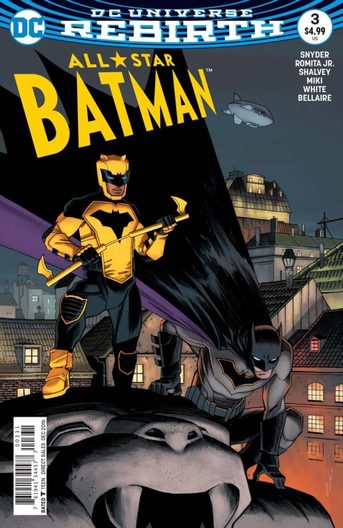 In my excitement to talk about silly gadgets in my last All-Star Batman article I may have neglected to fill in a few plot details that are crucial to following the story. So here’s a quick recap of the rest of Part 2: In a flashback Scott Snyder reveals that Great White, Black Mask, and Penguin have hired Anatoli Knyazev (KGBeast) to kill Batman in order to protect their secrets from seeing the light of day. Knyazev agrees provided he is allowed to be messy about it. Also, we see Alfred and Lark discussing the difference between the cartoonish villain that Lark grew up seeing on TV and the twisted evil Two-Face that Batman faces today. Alfred believes that the good half of Two-Face causes the evil side to act more extravagantly so that he can be caught. The transition between the two personalities seems to begin just before some of Two-Face’s more cartoonish crimes. While discussing Harvey and Batman’s plan to cure Two-Face, Lark is shocked to see the molecular structure of the cure Dent was working on is very similar to the substance that drove his family crazy. Lark tells Alfred that Bruce is walking into a trap and rushes off to warn him. After trading blows and quips with Two-Face, Batman ends up tied up in the back of a police van speeding toward the shadowy outline of KGBeast. He opens fire and issue 2 ends by showing the Beasts standing in the wreckage of the police van. As issue 3 begins Batman is tasked with fighting the artificially enhanced KGBeast one-handed as the unconscious Harvey Two-Face is tied to his left hand. Snyder treats us to a detailed catalog of the Beast’s weaponry and superhuman reflexes as he and Batman trade blows wielding only a gauntlet of bat-symbol brass knuckles. As Knyazev closes in for the kill, Lark appears and drives a car into the middle of his back. Batman helps Harvey into the vehicle and they escape, headed for a nearby safe house. As the Beast staggers to his feet, Snyder adds an especially playful element to the issue: the Royal Flush Gang appears on their signature Flying Ace hovercraft in the sky above the Beast asking which way Batman has gone. Knyazev says nothing and blasts them out of the sky. One of my favorite aspects of the All-Star Batman series has been the freedom that Snyder exercises with Batman’s Rogues Gallery. By setting up a narrative where Batman and Two-Face move rapidly from place to place dodging new threats left and right, we can see a complex, recognizable team like the Royal Flush Gang for a panel or two without feeling cheated when they are dispatched so quickly. Snyder barrels over and through villains the way Batman has to, and it’s awesome to see little cameos like that. Speaking of cameos, the host that welcomes Batman and company to the safe house was an unexpected surprise that made me smile as a Batman fan. The mute inventor Harold Allnut is not one of the more famous members of the Bat-Family but in his early days as Batman, Bruce Wayne relied on Allnut for his gadgetry and the maintenance of his vehicles. Every character in All-Star Batman is given a detailed caption almost like what Batman would read through a heads-up display, and the one Snyder gives to Allnut could not be more appropriate: “Harold Allnut: Genius Inventor. Mute. Family.” By including Allnut in this issue, Snyder reinforces something subtly different about Batman in this series. By choosing Duke as a sidekick, but not as another Robin it seems that Batman is attempting to break a cycle of sidekick dysfunction that has plagued the Bat-Family for years. Dick Grayson’s rebellion, Barbara Gordon’s paralysis, Jason Todd’s murder and sinister resurrection, are all examples of the dark shadow Batman has cast over the people he allows closest to him. Harold’s inclusion here is not just a nod to the die-hard fans who will remember the quirky inventor but an example of a relationship of Batman’s that has not ended in ashes. The warmth and gratitude that Batman expresses to Allnut shows camaraderie and compassion in a character who too often appears as an alienating ivory tower. 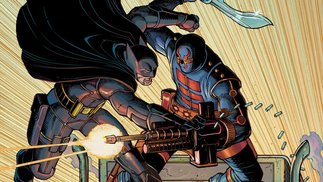 As Allnut tends to Harvey and Bruce’s wounds, Duke reveals the formula Harvey was working on to include a volatile ingredient that led to his mother’s current insanity. Batman is convinced that the formula will work and is hell-bent on completing the journey. After a fair amount of prodding Duke manages to get the answers from Bruce we’ve all been waiting for: where is this house they’re heading for and why is he so determined to get there no matter the cost. Apparently, Bruce Wayne and Harvey Dent bonded over their trauma as boys at a summer retreat for struggling children. Bruce’s anger at Joe Chill for the murder of his family and thirst for revenge worried Alfred so he sent him off to the Arkham Family Mansion where he met young Harvey Dent. Dent’s father was an abusive drunk and the boy was sent to the retreat for surprising his father one night and leaving him tied up for a few days. The boys became as close as brothers and though the retreat was closed after the summer they met there, they planned to reopen it when they became men so that others might benefit from friendships like the one they shared. But then Dent’s accident turned him into Two-Face and the vision the two boys shared was shattered. That house was where they were going, and their boyhood friendship was the reason for Bruce’s determination to help Harvey. In my article on the first issue in this series I was struck by the intimacy that we were going to get from the road trip scenario. By positioning Two-Face and Batman so close together and isolating them from the towering spires of Gotham City, Snyder set up a dynamic rarely seen in Batman comics. But with this brothers-in-trauma history between young Bruce Wayne and Harvey Dent, Snyder adds so much weight to their relationship and so much intimacy to the men that they grew into. It really makes you reevaluate your perception of Harvey Dent. To me he has always been the upstanding Public Defender twisted by a cruel accident that fractured his personality, but now I see a boy who could’ve grown into a hero very similar to Batman himself if not for some tough breaks. Patched up and nearly to their destination Batman, Lark, and Two-Face continue their journey via fan-boat only to be ambushed yet again. As the battle rages on Two-Face hints to Batman that he and Harvey may not be so split as he once thought, that perhaps when Bruce thought he was talking to Harvey it may have been Two-Face playing a part. Two-Face also reveals that he was listening to Bruce’s touching story about two struggling kids and their pure friendship and accuses him of polishing a tale that might not be so savory. Batman barely has time to process this horrible thought before Two-Face treats him to an acid bath straight into his eyes. Bruce’s eyes go dark as the issue ends. Will Batman ever see again? Is there indeed a cure for what Harvey has become? What didn’t Bruce tell Duke about his and Harvey’s friendship? Until next time, Geek On! Written by Joel T. Lewis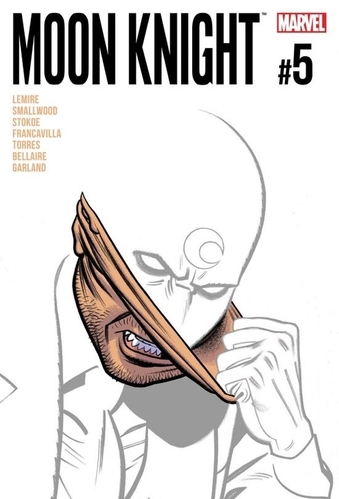 When we last left Marc Spector he was being confronted on the steps of a massive pyramid by someone claiming to be Moon Knight. As they grapple the imposter claims to be Marc Spector from a time before he lost his mind. Marc declares, “I am not insane!” as he stabs the imposter in the gut in a desperate attempt to end the fight, but his last ditch effort is unsuccessful. The imposter head-butts Spector saying, “you don't know what you are” and runs off with Marlene leaving Spector stunned and alone. As he rushes inside the pyramid after his attacker, Spector shoves open a heavy stone door and steps out onto the moon. That's right. Marc Spector finds himself in a space suit on the surface of the moon. Spector follows the trail of footsteps and blood to another door cut out of moon-rock but before he can open it he turns around to investigate a strange growling sound. He quickly discovers the source: a pack of blood-thirsty werewolves. On the moon. You read all of that correctly dear audience Jeff Lemire has indeed written a Moon Knight story in which Marc Spector is on the moon being chased by space werewolves. This madness lasts a mere three pages before Spector makes it through a second door which opens onto a film set. Spector is approached by Marlene dressed as Stained Glass Scarlet (an old Moon Knight villain) and calls him “Steven Grant” (the name he took on as his first alias when he became Moon Knight). Spector discovers later that this version of Grant is a millionaire film producer who has cast Marlene in one of his pictures. Neither Spector nor the reader has much time to process this shift as the two asylum orderlies from issues passed appear and chase Spector through yet another door marked with a crescent moon. Through this door Spector finds himself in a neon-noir style New York dressed as Jake Lockley, another former alias of the Moon Knight. The orderlies continue to chase him through this technicolor world and even manage to catch Spector momentarily before being subdued by him once again. Spector makes his way through another door with a crescent moon and stumbles upon a jail cell occupied by the god Seth. Remember a couple issues back when I made a heartfelt case for Khonshu as a compassionate fatherly figure? As it turns out I may have spoken too soon. The gauntlet of madness and reality that Spector has been running through was not orchestrated by Seth but by Khonshu. It was Khonshu who planned to use Marc’s weakened mind as a gateway to the real world. As heartbreaking as all of that is, Khonshu’s suggestion at the climax of this four-issue arc hurts the most, “Then let me take the pain away. Let me in and it will all stop. The pain. The confusion. You know you just want peace Marc. It can all end now. Give me your body, your mind. So I can be born into this world. You have served me well, child. Now you can rest. Your work is done. You can be free.” Khonshu asks for a conscious sacrifice from a broken man. A man that Khonshu broke. As he listens to all of this you can trace the defiance, betrayal, and finally resolve in Marc’s face as the panels slip passed. His answer? No. Spector then hurls himself off the side of the pyramid toward a rough landing soaking the sand in blood. Though triumphant in this last act of defiance Spector’s journey is far from over. The final pages of the issue show Spector waking up as Steven Grant. Grant has been asleep next to the star of his latest film project Marlene and as he gazes out over the New York City skyline he smiles. This final issue in the “Welcome to New Egypt” storyline was as fitting a conclusion as we could have hoped for. Shifting personas with corresponding art style switches, yet another layer to the twisted relationship between Marc Spector and Khonshu, and space werewolves. Let's not forget that those made an appearance in this issue along with all the other madness. Once again Jeff Lemire demonstrates his appreciation for the character of Moon Knight while sending him off into space. Literally. Until next time, Geek On! Written by Joel T. Lewis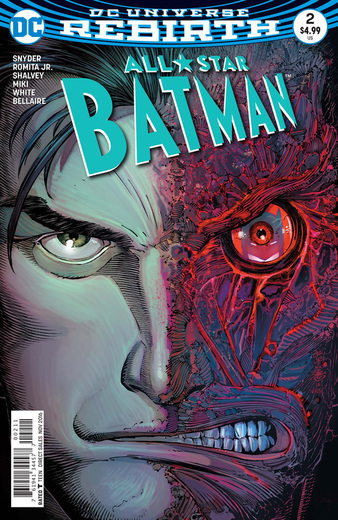 There are two Batmans as far as I’m concerned. There’s the dark, brooding titan of Justice whose shadowy silhouette strikes fear into the heart of Gotham’s criminal underworld, and then there’s the campy, silly, gadget-toting Batman portrayed by Adam West in the live action Batman T.V. series and the Batman ‘66 comics. I love them both dearly. Somehow Scott Snyder found the middle ground between these two portrayals in All-Star Batman and it is so much fun to read. As Batman and Two-Face continue their journey cross-country they find themselves on the top of a high-speed train. Batman trades blows with villains whose size and madness increase as the train accelerates through scenery reminiscent of the old west. Killer Croc, King Shark, and Amygdala (a trio I was excited to see working together) attempt to rescue Two-Face from Batman with little success. With scenery whizzing by Batman dispatches each muscle-bound foe while balancing atop the speeding train in panels that feel like an old west train robbery sequence. Once free of the hulking villains, Batman scarcely has time to breathe before being accosted by toxin specialists Cheshire and Copperhead. The issue is fast-paced and exhilarating, and Snyder continues to do interesting things as he jumps back and forward in time. By showing us Commissioner Gordon just a few days in the future preparing a raid of Wayne Manor, Snyder expresses how tight Two-Face’s hold over Gotham really is. Even Gordon, Batman’s greatest ally in the GCPD cannot allow Gotham to weather the storm of what Two-Face can reveal. These jumps in time also build up tension, giving each panel set in the present a sense of immediacy and narrative weight. These glimpses of the future deepen our understanding of how corrupt and broken Gotham is and how desperate its citizens are to hide that fact. Batman’s greatest asset is that he is always prepared for every situation so, naturally we have seen some strange and silly gadgets throughout his history. Snyder references two of Batman’s most ridiculous gadgets in two consecutive pages and elevates them, basking in their silliness. Issue no. 22 of the Batman and Robin (2009) series found the Dark Knight in a last ditch effort to come out on top while grappling with the White Knight. Out of options, Batman triggers spring-loaded ears which shoot up into the Knight’s head. Robin’s question in the following panel echoes the voices of the audience unsure of what just happened, “Are those your cowl ears sticking in his head?” Yes Robin, they are, and while silly, of course Batman has spring-loaded bat-ears! Snyder plays a variation on this gadget in All-Star Batman No. 2: as Amygdala holds Batman up to meet the fast-approaching tunnel roof on top of the train Batman reaches up and detaches his ears, revealing them to be wicked-looking knives. The panel transition is so quick that you nearly miss what Batman has plunged into Amygdala’s arms but after a double-take you accept the truth: of course Batman’s ears are knives! 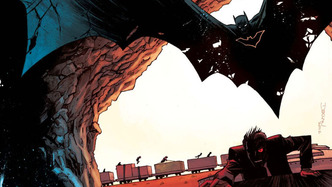 When you think of silly Bat-Gadgets none is more infamous than the one that caused such an uproar in 1966’s Batman: The Movie. While dangling from the Bat-Copter and grappling with a blatantly rubber shark Batman calls for the one thing in his arsenal that can vanquish his finned foe: Shark Repellant Bat-Spray. The inclusion of this silly gadget in the movie from 1966 has endured years of criticism but it is not the first appearance of Shark Repellant in Batman canon (it appears in Batman No. 117). Nor was it the last. Now remember that in this issue Batman finds himself on top of a speeding train, facing Amygdala, Killer Croc, and King Shark. After dispatching Amygdala with his cowl-knives Batman turns to King Shark and he’s got an old trick up his cape. Batman aims a few smoke pellets at King Shark’s head and he recoils, unable to handle the stench. This sends King Shark and Amygdala over the side of the train. In the next panel Killer Croc asks the question on all our minds, “What were those things? Shark-Repellent? Smells like--” Batman responds, detailing the exact formula of what he threw at King Shark, “Dead Shark Matter? Copper Acetate mixed with Boric Acid.” It’s shark-repellent Batman, we all know it’s shark-repellent. Snyder continues to intrigue and innovate in his All-Star Batman series. Some have balked at the $4.99 price of every issue, which can be steep for DC fans tracing the lines of the Rebirth comic event. However, if you can swing the extra $2.00 per issue, at the end of every issue Snyder tackles the training of Batman’s newest sidekick Duke Thomas AKA Lark in little mini-issues. It’s very refreshing to read about Batman’s new training method and a new hero following the legion of Robins we’ve had over the years. Lark is all that you want and more in a Batman sidekick: complex, tragic, and rebellious in that classic Bat-Family way. Until next time, Geek On! Written by Joel T. Lewis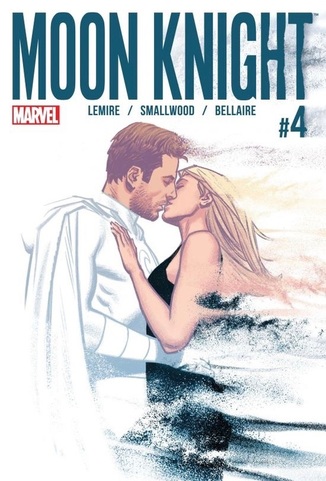 Now that we’re four issues into Jeff Lemire’s Moon Knight run I want to talk about cliffhangers. They have been a part of how we consume stories throughout the evolution of entertainment. The serialized novels of Dickens, radio dramas, T.V. shows, and comic books are all designed to leave their audience desperate for more. But in a world of streaming-service binging and instant gratification media the cliffhanger can seem a bit trite. We hear the modern equivalent of “tune-in next week” and we sigh in frustration. It’s hard to wait to find out what happens next when we have gotten used to a show only being interrupted by Netflix checking to see if you’ve fallen asleep. Recently even I’ve complained, rather loudly, about season finales that stop short of gratification for reasons I could only rationalize as inflated confidence in ratings. Whether that belief was founded upon fact or I just really wanted to know who Negan killed on The Walking Dead back in April I cannot honestly say but it’s how I felt. But the cliffhanger can still be an effective plot device. When curiosity overcomes impatience and shock deflates frustration, that’s effective storytelling. Jeff Lemire accomplishes just that. There has not been a single issue of the 2016 run of Moon Knight (and I have read all 8 issues in print) where the cliffhanger has disappointed me. Issue 1 ended with Spector emerging from the confines of Ammut’s asylum to discover a New York overrun with desert sand and high-rise pyramids. Issue 2 showed us a subway car full of Mummies and issue 3 gave us a street-level view of Egyptian New York and a sky full of winged jackals. But nothing could have prepared me for the bombshell that comes on page 21 of issue no. 4. 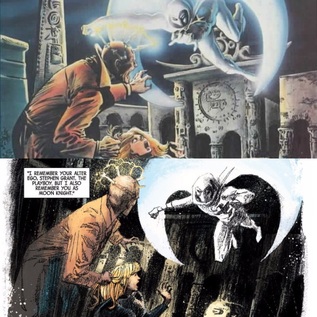 As Marc Spector and company pass through the streets of New Egypt their numbers dwindle further as Jean-Paul is savaged by Sobek and Gena stays behind at her diner. These losses hit hard but luckily Marlene regains consciousness and gives Spector some much needed assurance. She remembers their life together, she remembers him as Moon Knight, and for the briefest moment Spector is confident in his sanity. Marlene’s memories come to life as artist Greg Smallwood masterfully recreates the cover of Marvel Preview no. 21(1980). This panel pays homage to and validates that original cover in the same way that Marlene’s memories validate our faith in the Moon Knight narrative. We can feel safe and confident again in Moon Knight’s sanity, if only for the briefest moment. As Marlene and Spector climb the steps of the Pyramid, Spector is struck by something small, sharp, and in the shape of a crescent moon. “Who...?!” exclaims Spector as he turns to see his assailant. “I’m Moon Knight, you lunatic.” is the answer. Now I realize that I’m beginning to sound like a broken record about how insecure I feel as a Moon Knight fan reading Lemire’s issues, but this hit me like a ton of bricks. Lemire isn’t just putting Moon Knight through the psychological wringer here, he’s doing it to the reader too. Marlene’s acknowledgement of Marc Spector as Stephan Grant and Moon Knight was a vital life raft to me in the same way it was to Spector. I could breathe again. Smallwood’s homage to a vintage cover I had seen, referencing a story I had read meant the world to me and Spector. That panel served as a canonical touchstone that validated the history of the character for me and with a deftly thrown crescent dart Lemire shattered my confidence in Moon Knight again. I was breathless, I was speechless, and I was desperate to tune in for the next adventure of Moon Knight. Written by Joel T. Lewis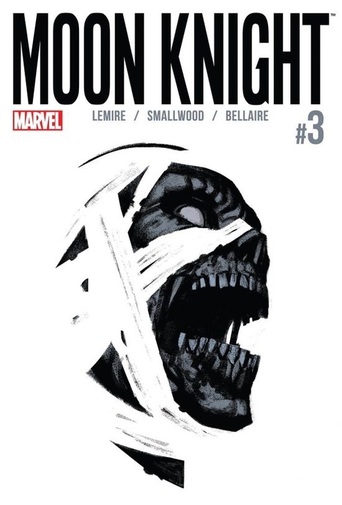 As they continue to make their escape from the nightmarish asylum, Moon Knight and company discover that the path ahead is as treacherous as the one behind. While they are being pursued by Ammut and the asylum orderlies they run head first into a New York subway car teaming with mummies. There are mummies! Coming out of subway cars! Spector is not phased as he applies the old moon fists to mummified faces allowing his group to narrowly escape. Unfortunately they can’t escape before Ammut drugs Marc Spector, taking away his ability to see Dr. Emmet as the alligator-headed god Ammut and the asylum orderlies as the jackal-headed lackeys they are. Even in his weakened state Spector is able to break free, but robbed of his visions of the “truth” Spector’s faith is shaken again. This is the second issue in a row that Jeff Lemire examines the tumult of Spector’s psyche through a conversation between Spector and Khonshu. Spector asks, “I can’t see see the truth. Tell me Khonshu...is this all real? Or am I really just mad?” to which Khonshu offers an unexpected response, “Does it matter?” Does it matter if Marc Spector is truly mad? This is a question I have been frightened to ask myself throughout this most recent run of Moon Knight. Can I cope with the possibility that Spector has been in a psych ward all these years and all his escapades that I’ve spent hours reading have all been fevered ravings of a damaged mind? Khonshu continues, “Does it matter if you’re mad? Your madness is your gift Marc. What will keep you alive. You need to stop fighting it. Give in to it. Let your insanity guide you. Let your madness show you the way.” As Khonshu imparts this wisdom to his disciple the following panels are illuminated where they once were pitch black. It is as if Spector’s madness has shone its light on the darkness of his sanity. As Spector is reunited with his friends they encounter Anubis, escort of the underworld and Crawley agrees to sacrifice himself so that the others might continue on their journey. The selflessness of Crawley’s sacrifice is yet another example of the care with which Lemire has taken the reigns of the Moon Knight series. Throughout Moon Knight’s history time and again Crawley has demonstrated unexpected charity and compassion and Lemire’s portrayal of him as so selfless is wonderful to see. As Crawley follows Anubis towards judgement, Spector and the others finally emerge above ground on the streets of New Egypt, formerly New York. I don’t want to gloss over the importance of the appearance of mummies in this issue of Moon Knight. For a character brought back to life by the grace of an Egyptian God of the Moon, Moon Knight has not spent much time fighting off what might be considered typical Egyptian foes, namely Mummies. We’ve seen monks, African warlords, crossbow temptresses, other Egyptian priests and werewolves, but very few of the undead variety have graced the pages of a Moon Knight comic. But our patience has finally paid off in a big way thanks to Jeff Lemire. There are very few things that please me the way seeing Moon Knight punch actual mummies in a comic from 2016 did. They crunch, they shatter, and they turn to dust under the barrage of fists doled out by old Moonie and it's very satisfying to follow from panel to panel. Written by Joel T. Lewis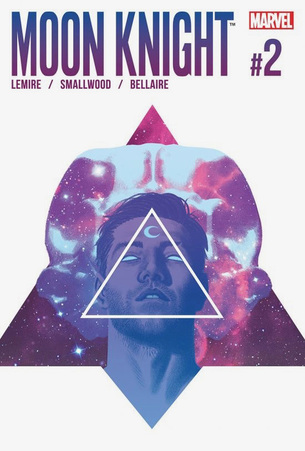 While escaping the clutches of the ominous “reality” of the psych ward that Marc Spector finds himself in is the central plot of the second issue of Moon Knight, writer Jeff Lemire dedicates a substantial chunk of the issue to redefining a relationship that’s crucial to the Moon Knight mythos. Khonshu and Marc Spector’s relationship has been underdeveloped for most of Moon Knight’s history. Starting as an ominous statue which silently looms over Spector as he dies in Egypt, Khonshu loomed as a presence that impacted how Spector made difficult decisions in the earlier runs of Moon Knight. Spector does consult the statue in a way, cursing it and begging for its help, but Spector’s “prayers” if they can be called such, go unanswered, at least to the audience. There is some sense in the early comics that Marc hears a response in his own head but more recently Khonshu has begun to speak to Spector loud enough for the reader to hear. This second incarnation of Khonshu served as a more sinister version of the shoulder devil we used to see in Bugs Bunny cartoons; spurring Spector to deal out as much pain and suffering as possible. This Khonshu is continually disappointed in his choice of Spector as an avatar especially when Moon Knight clashes with his arch-nemesis, Raoul Bushman or the Punisher. Khonshu lusts after these characters because they do not hesitate to kill while Spector is always reluctant to give in to pure bloodlust. While the questions raised about Spector’s psyche by this manifestation of Khonshu are interesting and the character is quippy and as carnage-happy as you would like, this version of Khonshu can be a bit of a one trick pony. Spector’s relationship with this Khonshu is mainly that of doormat as he is browbeaten into carving crescent moons into the foreheads of his victims and even murdering them. Lemire’s Khonshu is more nuanced and rounded out than the previous incarnations. Even his fossil-bird appearance is more refined as he dons a white on white suit in his conversations with Spector. But what is most striking about Lemire’s Khonshu is the genuine fatherly affection he feels for Spector that comes across in this issue. This issue marks the first long form conversation between Spector and Khonshu in this run and it starts with a bit of “same song second verse” syndrome as Khonshu snaps at his disciple. But this anger melts away after a single panel and Khonshu actually apologizes to Marc. This is an unprecedented gesture that instantly shifts the dynamic of God and Priest into Father and Son. Khonshu is almost tender as he explains that his race, the race that the ancient Egyptians called their gods, came from the “Othervoid” a place separate from space and time. 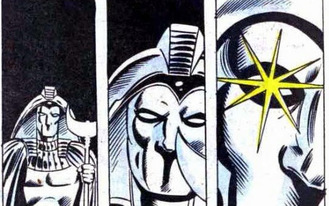 During the reign of the ancient Egyptians Khonshu and his kind were able to travel freely between the “Othervoid” and the dimension where earth resides, but no longer. Now the old gods have to seek out hosts in order to act in Spector’s dimension. Apparently Spector’s weak mind attracted Khonshu to use him as a host and that same weak mind is what the other gods are using in order to find a way back to earth’s dimension. All of what Spector has been experiencing has been an elaborate illusion created by the god Seth. As Spector struggles to comprehend the scale of these revelations he asks the question on all of our minds, “How do I know if this is real?” This is the question Spector and Moon Knight readers have been asking for years and the answer Khonshu gives us would be frustrating if it wasn’t so sincere: “You don’t. That is the hard part. Now you must have faith.” Khonshu knows how fragile Spector’s mind is, he knows what he’s put him through, and the compassion that was always missing from this God and Priest relationship finally shines through. While the plot-driving events of this issue are compelling enough to make you pick up the next issue this expositional scene is a testament to how seriously Lemire takes his job. The affection he has shown for the history of Moon Knight and his creativity in breaking down the insecurity we and Marc Spector feel about his sanity is breathtaking. Written by John Edward Betancourt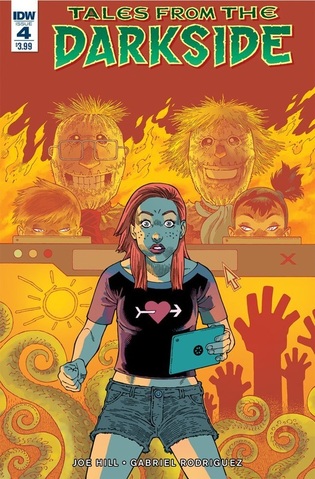 It's no secret that I have been absolutely enamored by IDW's comic book revitalization of Tales from the Darkside and with good reason. It's a faithful follow up to an iconic show, paying respect where it is due, but all the while adding new wrinkles to the mythos along the way. Because of the quality that has gone into this, it made today's review a difficult one, because the fourth issue of this stunning series...is also its last. Yes, since the rebooted series never reached the airwaves there are only so many scripts that Joe Hill penned, and we have come to the last of them from that pile and well...they most certainly saved the best for last. Because not only does 'The Window Opens' wrap up the whole 'Black Box' storyline, it prepares us for something far more nefarious and in a way...perhaps explains this whole universe to us in the process. This go round, we meet a young girl named Joss Waldrop and she's new to the neighborhood. On a seemingly boring day, Joss is terrified at the brief glimpse of a man appearing and disappearing before her while she's behind the wheel of her car, forcing her to run off the road and smash into a mailbox and apologize profusely to the family inside the house for damaging their property. But the quirky heads of the household think of an easy way for her to make up for her mistake, just babysit the kids tonight and all will be well. But little does Joss know, the two children in this household have discovered the gateway to the Darkside on their tablet computers...and she will be in for one incredible night of terror as they begin to play with reality and the horrible things that lurk in the shadows. So, out of the four 'episodes' that IDW published, this one is my favorite by far. It ties all four stories together by revealing that Briterside's notion of control has completely backfired and unleashed an evil upon the world in Big Winner. Reality is no longer what it seems and the parallel world of the Darkside is ready to claim lives at will. That means in a roundabout sort of way, this final book serves as a prequel to the whole mess, that the horrible tales we enjoyed so long ago are people like Joss, trapped in a world they cannot explain where awful things happen on a regular basis and Brian Newman is more or less the patient zero of it all. It's a stroke of genius and all origin story aside, the story inside this issue is equally as impressive, filled to the brim with chilling visuals as the children's ideas come to life and my particular favorite is the tentacle creature that emerges from the bedroom. However, despite this awesome finale to Joe Hill's run as Maestro of the Darkside, I am definitely sad to see this series come to an end. Tales from the Darkside was an influential television series, one that paved the way for the horror we enjoy on television today, so to see it resurrected, in any form was a big deal to me and no doubt to horror fans everywhere and one can only hope that Joe's incredible work on this series inspires someone to resurrect this series on television in some form or fashion because it's clear from these four issues, there are plenty of scary places that we can still go in this universe and at the minimum, I certainly hope that IDW decides to pick up this series as a regular run with a variety of different writers giving life to new and terrifying stories from the scariest places of our imagination. But for now, this good thing has come to an end and what better way to say goodbye than with the chilling reminder that...'The Darkside is always there, waiting for us to enter...waiting to enter us. Until next time, try to enjoy the daylight.' |
Archives
May 2024
|
|
© 2012-2025, Nerds That Geek LLC.
All Rights Reserved. |
uWeb Hosting by FatCow
